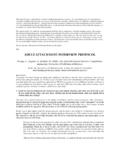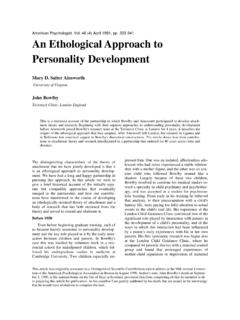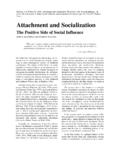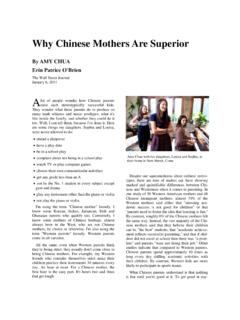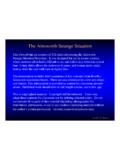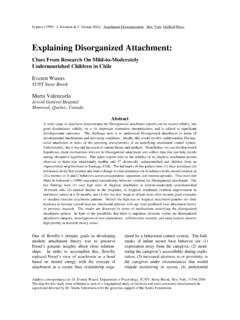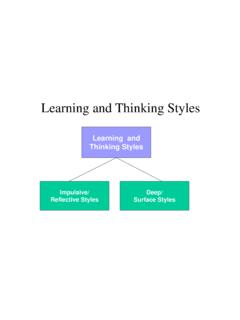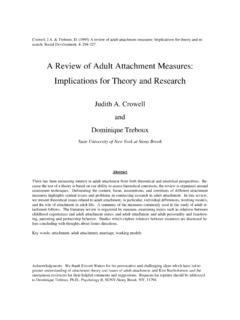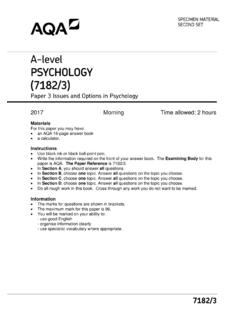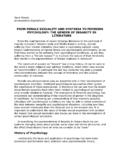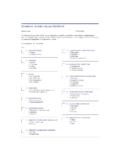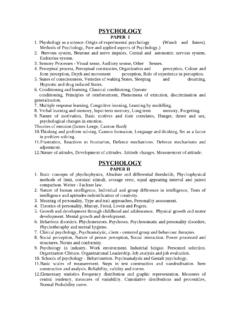Transcription of THE ORIGINS OF ATTACHMENT THEORY ... - …
1 THE ORIGINS OF ATTACHMENT THEORY : JOHN BOWLBY AND MARY AINSWORTH INGE BRETHERTON ATTACHMENT THEORY is the joint work of John Bowlby and Mary Ainsworth (Ainsworth & Bowlby, 1991 ). Drawing on concepts from ethology, cybernetics, information processing, developmental psychology, and psychoanalysts, John Bowlby formulated the basic tenets of the THEORY . He thereby revolutionized our thinking about a child s tie to the mother and its disruption through separation, deprivation, and bereavement. Mary Ainsworth s innovative methodology not only made it possible to test some of Bowlby s ideas empirically hut also helped expand the THEORY itself and is responsible for some of the new directions it is now taking. Ainsworth contributed the concept of the ATTACHMENT figure as a secure base from which an infant can explore the world. In addition, she formulated the concept of maternal sensitivity to infant signals and its role in the development of infant-mother ATTACHMENT patterns.
2 The ideas now guiding ATTACHMENT THEORY have a long developmental history. Although Bowlby and Ainsworth worked independently of each other during their early careers, both were influenced by Freud and other psychoanalytic thinkers-directly in Bowlby s case, indirectly in Ainsworth s. In this chapter, I document the ORIGINS of ideas that later became central to ATTACHMENT THEORY . I then discuss the subsequent period of THEORY building and consolidation. Finally, I review some of the new directions in which the THEORY is currently developing and speculate on its future potential In taking this retrospective developmental approach to the ORIGINS of ATTACHMENT THEORY , I am reminded of Freud s (1920/1955) remark: I would like to thank Mary Ainsworth and Ursula Bowlby for helpful input on a draft of this article. I am also grateful for insightful comments by three very knowledgeable reviewers. Reference: Developmental Psychology (1992), 28, 759-775.
3 Reprinted in from R. Parke, P. Ornstein, J. Reiser, & C. Zahn-Waxler (Eds.) (1994). A century of developmental psychology. (Chapter 15, pp. 431-471). Reference: Developmental Psychology (1992), 28, 759-775. So long as we trace the development from its final outcome backwards, the chain of eventsappears continuous, and we feel we have gained an insight which is completely satisfactoryor even exhaustive. But if we proceed in the reverse way, if we start from the premisesinferred from the analysis and try to follow these up to the final results, then we no longerget the impression of an inevitable sequence of events which could not have otherwise beendetermined. (p. 167)In elucidating how each idea and methodological advance became a stepping stone for thenext, my retrospective account of the ORIGINS of ATTACHMENT THEORY makes the process of theorybuilding seem planful and orderly. No doubt this was the case to some extent, but it may often nothave seemed so to the protagonists at the BowlbyAfter graduating from the University of Cambridge in 1928, where he received rigorousscientific training and some instruction in what is now called developmental psychology, Bowlbyperformed volunteer work at a school for maladjusted children while reconsidering his careergoals.
4 His experiences with two children at the school set his professional life on course. One wasa very isolated, remote, affectionless teenager who had been expelled from his previous school fortheft and had had no stable mother figure. The second child was an anxious boy of 7 or 8 whotrailed Bowlby around and who was known as his shadow (Ainsworth, 1974). Persuaded by thisexperience of the effects of early family relationships on personality development, Bowlbydecided to embark on a career as a child psychiatrist (Senn, 1977h).Concurrently with his studies in medicine and psychiatry, Bowlby undertook training at theBritish Psychoanalytic Institute. During this period Melanie Klein was a major influence there (theinstitute had three groups: Group A sided with Freud, Group B sided with Klein, and the MiddleGroup sided with neither). Bowlby was exposed to Kleinian (Klein, 1932) ideas through histraining analyst, Joan Riviere, a close associate of Klein, and eventually through supervision byMelanie Klein herself.
5 Although he acknowledges Riviere and Klein for grounding him in theobject-relations approach to psychoanalysis, with its emphasis on early relationships and thepathogenic potential of loss (Bowlby, 1969, p. xvii), he had grave reservations about aspects ofthe Kleinian approach to child psychoanalysis. Klein held that children s emotional problems arealmost entirely due to fantasies generated from internal conflict between aggressive and libidinaldrives, rather than to events in the external world, She hence forbade Bowlby to talk to themother of a 3-year-old whom he analyzed under her supervision (Bowlby, 1987). This wasanathema to Bowlby who, in the course of his postgraduate training with two psychoanalyticallytrained social workers at the London Child Guidance Clinic, had come to believe that actualfamily experiences were a much more important, if not the basic, cause of emotional s plan to counter Klein s ideas through research is manifest in an early theoreticalpaper (1940) in which he proposed that, like nurserymen, psychoanalysts should study the natureof the organism, the properties of the soil, and their interaction (p.)
6 23). He goes on to suggestthat, for mothers with parenting difficulties,a weekly interview in which their problems are approached analytically and traced hack tochildhood has sometimes been remarkably effective. Having once been helped to recognizeand recapture the feelings which she herself had as a child and to find that they are acceptedtolerantly and understandingly, a mother will become increasingly sympathetic and toleranttoward the same things in her child. (Bowlby, 1940, p. 23)These quotations reveal Bowlby s early theoretical and clinical interest in the intergenerationaltransmission of ATTACHMENT relations and in the possibility of helping children by helping object-relations theories later proposed by Fairbain (1952) and Winnicott (1965)were congenial to Bowlby, hut his thinking had developed independently of s first empirical study, based on case notes from the London Child Guidance Clinic,dates from this period. Like the boy at the school for maladjusted children, many of the clinicpatients were affectionless and prone to stealing.
7 Through detailed examination of 44 cases,Bowlby was able to link their symptoms to histories of maternal deprivation and World War II led to an interruption in Bowlby s budding career as a practicingchild psychiatrist, it laid further groundwork for his career as a researcher. His assignment was tocollaborate on officer selection procedures with a group of distinguished colleagues from theTavistock Clinic in London, an experience that gave Bowlby a level of methodological andstatistical expertise then unusual for a psychiatrist and psychoanalyst. This training is obvious inthe revision of his paper, Forty-Four Juvenile Thieves: Their Characters and Home Lives (Bowlby, 1944), which includes statistical tests as well as detailed case the end of World War II, Bowlby was invited to become head of the Children sDepartment at the Tavistock Clinic. In line with his earlier ideas on the importance of familyrelationships in child therapy, he promptly renamed it the Department for Children and , in what is credited as the first published paper in family therapy, Bowlby (1949) describeshow he was often able to achieve clinical breakthroughs by interviewing parents about theirchildhood experiences in the presence of their troubled Bowlby s chagrin, however, much of the clinical work in the department was done bypeople with a Kleinian orientation, who, he says, regarded his emphasis on actual familyinteraction patterns as not particularly relevant.
8 He therefore decided to found his own researchunit whose efforts were focused on mother-child separation. Because separation is a clear-cut andundeniable event, its effects on the child and the parent- child relationship were easier todocument than more subtle influences of parental and familial AinsworthMary Ainsworth (nee Salter), 6 years younger than Bowlby, finished graduate study at theUniversity of Toronto just before World War II. courses with William Blatz had introduced herto security THEORY (Blatz, 1940), which both reformulated and challenged Freudian ideas, thoughBlatz chose not to recognize his debt to Freud because of the anti-Freudian climate that pervadedthe University of Toronto at that time (Ainsworth, 1983; Blatz, 1966).One of the major tenets of security THEORY is that infants and young children need to developa secure dependence on parents before launching out into unfamiliar situations. In her disserta-tion, entitled An Evaluation of Adjustment Based Upon the Concept of Security, Mary Salter(1940) states it this way:Familial security in the early stages is of a dependent type and forms a basis from whichthe individual can work out gradually, forming new skills and interests in other familial security is lacking, the individual is handicapped by the lack o~ whatmight be called a secure base italics added from which to work.
9 (p. 45)Interestingly, Mary Salter s dissertation research included an analysis of students autobiographi-cal narratives in support of the validity of her paper-and-pencil self-report scales of familial andextrafamilial security, foreshadowing her later penchant for narrative methods of data , few researchers realize the enormous experience in instrument development and diagnos-tics she brought to ATTACHMENT Bowlby s, Mary Salter s professional career was shaped by her duties as a militaryofficer during World War 11 (in the Canadian Women s Army corps). After the war, as a facultymember at the University of Toronto, she set out to deepen her clinical skills in response to therequest to teach courses in personality assessment. To prepare herself for this task, she signed upfor workshops by Bruno Klopfer, a noted expert in the interpretation of the Rorschach test. Thisexperience led to a coauthored book on the Rorschach technique (Klopfer, Ainsworth, Klopfer,& Holt, 1954), which is still in 1950, Mary Salter married Leonard Ainsworth and accompanied him to London, wherehe completed his doctoral studies.
10 Someone there drew her attention to a job advertisement in theLondon Times that happened to involve research, under the direction of John Bowlby, into theeffect on personality development of separation from the mother in early childhood. As MaryAinsworth acknowledges, joining Bowlby s research unit reset the whole direction of herprofessional career, though neither Bowlby nor Ainsworth realized this at the EMERGENCE OF ATTACHMENT THEORYIn 1948, 2 years before Ainsworth s arrival, Bowlby had hired James Robertson to help himobserve hospitalized and institutionalized children who were separated from their had had impeccable training in naturalistic observation, obtained as a conscientiousobjector during World War II, when he was employed as a boilerman in Anna Freud s Hampsteadresidential nursery for homeless children. Anna Freud required that all members of the staff, nomatter what their training or background, write notes on cards about the children s behavior(Senn, l977a), which were then used as a basis for weekly group discussions.


